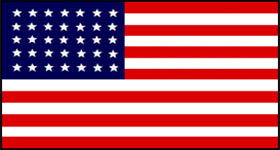Civil War Battles |
Colonial Wars |
American Wars |
Link To This Page — Contact Us —
The Battle of Vincents Crossroads
October 26, 1863 in Vincents Crossroads, Mississippi
Union Forces Commanded by:
Brig. Gen. Samuel W. Ferguson
Confederate Forces Commanded by: ??
*Killed and Wounded/ m=missing Conclusion: Union-Confederate-Inconclusive Victory |
 |
BATTLE SUMMARY
The location of this action, involving elements of Brig. Gen. Samuel W. Ferguson's Brigade and the 1st Alabama (U.S.) Cavalry, has always been identified as being in Mississippi. Ferguson's report of the action, which took place on October 26, mentions taking the road towards Fulton and a crossroad leading to Bay Springs. Both of these locations are in Mississippi. However, Vincent's Crossroads is the former name of Red Bay, a community located just inside the Alabama state line in Franklin County. The following is Ferguson's report of this action:
HEADQUARTERS BRIGADE, Near Courtland, Ala., October 31, 1863.
"GENERAL: I have the honor to report that, pursuant to verbal orders from yourself, I left camp at Cane Creek shortly after dark on the evening of the 25th instant with two regiments of my brigade (the Second Tennessee, Lieutenant-Colonel Morton, and the Second Alabama, Colonel Earl), for the purpose of intercepting a raiding party of the enemy reported to be on their return from Walker County, Ala. Traveled all night, and at sunrise next morn tug halted and fed my horses at a ford of Bear Creek, about 2 miles above Mann's Mills. After a delay of two hours for this purpose, I pushed the command across Bear Creek and on to the Fulton and Iuka road. Here, as there was no sign of -the enemy's having passed, I turned toward Fulton, and after reaching the intersection of this road with that to Bay Springs, I sent one squadron in the latter direction for the purpose of holding the enemy in check, should they move toward that point, and preventing their escape. With the remainder of my force (about 300 effective men) I moved toward the Bull Mountain country.
After pursuing this road about 3 miles I received the first positive information of the position of the enemy from a scout I had sent out, who reported them advancing on the same road. I immediately sent to recall the squadron previously ordered to Bay Springs, and continued the march until the advance guards met and skirmishing began--about 1.30 p.m. The enemy were formed in thick woods across the road, with an open field in front, through which, swept as it was by two pieces of light artillery planted in the road, I had to advance to the attack. As rapidly as possible I formed my lines, had the men dismounted, and attacked the enemy, who were soon driven back by the Second Tennessee, under the able and gallant leadership of Lieutenant-Colonel Morton, and a portion of the Second Alabama. As soon as the horses could be brought up the fleeing enemy were hotly pursued and their retreat converted into a wild panic. The chase was kept up for some 10 miles through dense woods and over a mountainous country until dark. Their perfect knowledge and our ignorance of the country enabled most of them, however, to escape by separating into small squads and leaving the road.
It may be proper to remark that before the engagement began I had met Major Moreland, with his battalion, and ordered him to get in rear of the enemy on a road leading from their left flank to Bay Springs, of the existence of which he informed me, stating it was the only road by which they could escape, except directly back into Alabama. Had my instructions been strictly and energetically followed, few of the enemy would have escaped.
With a loss of 2 killed and 11 wounded, I have succeeded in effectually destroying the First Alabama Tory Regiment. Up to the time I left, the enemy's loss, as far as could be ascertained, was 20 killed, including 2 captains, the adjutant of the regiment, and 1 first lieutenant; 9 wounded, including 1 first lieutenant mortally, and 29 prisoners. The woods was so dense and the fight kept up for so great a distance that many killed and wounded were not found. I do not think the number would fall short of 100 in all.
I captured 2 pieces of artillery, 5 stand of colors, 60 elegant breech-loading carbines, with an ample supply of ammunition for present purposes, 25 Colt hostler pistols, 10 pack-saddles, 52 horses and mules, and 56 saddles. I have received no report from Major Moreland, but understand he has collected a large number of prisoners, horses, mules, &c. My force scarcely equaled that of the enemy.
I am indebted to the officers and men of the command for gallant conduct and cheerful endurance of hardship and hunger on this scout; but to Lieutenant-Colonel Morton and Maj. H. W. Bridges more than a passing tribute is due. The former led his gallant band with a cool skill and determination, admirable in the extreme, until knocked from his horse by a spent ball. The latter was, as usual, foremost in the fight, everywhere inspiring and encouraging the men and officers. With his own hand he killed 1 and wounded and captured several other Yankees. His horse was shot under him and his coat pierced by a bullet, an evidence of the close character of the fight.
To the officers of my staff who were present--Captain Nugent, assistant adjutant-general; Captain Irwin, assistant inspector-general; Lieutenant Tomlinson, aide-de-camp, and Lieutenant Richardson, picket officer--I am indebted for zealous and efficient discharge of duty in gallant style.
S. W. FERGUSON, Brigadier-General, Commanding.
